Functional interaction between Env oncogene from Jaagsiekte sheep retrovirus and tumor suppressor Sprouty2
- PMID: 20678191
- PMCID: PMC2922082
- DOI: 10.1186/1742-4690-7-62
Functional interaction between Env oncogene from Jaagsiekte sheep retrovirus and tumor suppressor Sprouty2
Abstract
Background: Jaagsiekte sheep retrovirus (JSRV) is a type D retrovirus capable of transforming target cells in vitro and in vivo. The Envelope (Env) gene from JSRV and from related retroviruses can induce oncogenic transformation, although the detailed mechanism is yet to be clearly understood. Host cell factors are envisaged to play a critical determining role in the regulation of Env-mediated cell transformation.
Results: JSRV Env-mediated transformation of a lung adenocarcinoma cell line induced rapid proliferation, anchorage-independent growth and tumor formation, but completely abrogated the migration ability. An analysis of the signaling scenario in the transformed cells suggested the involvement of the ERK pathway regulated by Sprouty2 in cell migration, and the PI3K-Akt and STAT3 pathways in proliferation and anchorage-independence. On the other hand, in a normal lung epithelial cell line, Env-mediated transformation only decreased the migration potential while the other functions remained unaltered. We observed that Env induced the expression of a tumor suppressor, Sprouty2, suggesting a correlation between Env-effect and Sprouty2 expression. Overexpression of Sprouty2 per se not only decreased the migratory potential and tumor formation potential of the target cells but also made them resistant to subsequent Env-mediated transformation. On the other hand, over expression of the functional mutants of Sprouty2 had no inhibitory effect, confirming the role of Sprouty2 as a tumor suppressor.
Conclusions: Our studies demonstrate that Env and Sprouty2 have a functional relationship, probably through shared signaling network. Sprouty2 functions as a tumor suppressor regulating oncogenic transformation of cells, and it therefore has the potential to be exploited as a therapeutic anti-cancer agent.
Figures
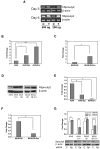
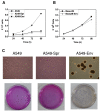
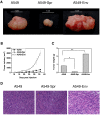
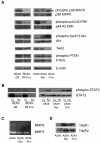
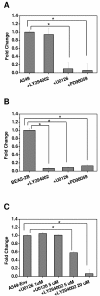
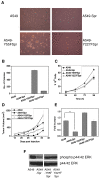
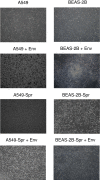
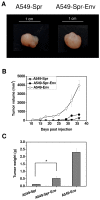

Similar articles
-
Transformation of rodent fibroblasts by the jaagsiekte sheep retrovirus envelope is receptor independent and does not require the surface domain.J Virol. 2003 Jun;77(11):6341-50. doi: 10.1128/jvi.77.11.6341-6350.2003. J Virol. 2003. PMID: 12743291 Free PMC article.
-
Jaagsiekte sheep retrovirus transformation in Madin-Darby canine kidney epithelial cell three-dimensional culture.J Virol. 2010 May;84(10):5379-90. doi: 10.1128/JVI.02323-09. Epub 2010 Mar 10. J Virol. 2010. PMID: 20219922 Free PMC article.
-
Envelope-induced cell transformation by ovine betaretroviruses.J Virol. 2002 Jun;76(11):5387-94. doi: 10.1128/jvi.76.11.5387-5394.2002. J Virol. 2002. PMID: 11991967 Free PMC article.
-
Oncogenic transformation by the jaagsiekte sheep retrovirus envelope protein.Oncogene. 2007 Feb 8;26(6):789-801. doi: 10.1038/sj.onc.1209850. Epub 2006 Aug 14. Oncogene. 2007. PMID: 16909114 Review.
-
Transformation and oncogenesis by jaagsiekte sheep retrovirus.Curr Top Microbiol Immunol. 2003;275:139-77. doi: 10.1007/978-3-642-55638-8_6. Curr Top Microbiol Immunol. 2003. PMID: 12596898 Review.
Cited by
-
Sprouty 2 binds ESCRT-II factor Eap20 and facilitates HIV-1 gag release.J Virol. 2011 Jul;85(14):7353-62. doi: 10.1128/JVI.00141-11. Epub 2011 May 4. J Virol. 2011. PMID: 21543492 Free PMC article.
-
The rise of bioscience in the East.Retrovirology. 2010 Dec 15;7:106. doi: 10.1186/1742-4690-7-106. Retrovirology. 2010. PMID: 21159179 Free PMC article.
-
Early Steps of Jaagsiekte Sheep Retrovirus-Mediated Cell Transformation Involve the Interaction between Env and the RALBP1 Cellular Protein.J Virol. 2015 Aug;89(16):8462-73. doi: 10.1128/JVI.00590-15. Epub 2015 Jun 3. J Virol. 2015. PMID: 26041289 Free PMC article.
-
Urokinase receptor orchestrates the plasminogen system in airway epithelial cell function.Lung. 2013 Apr;191(2):215-25. doi: 10.1007/s00408-013-9450-z. Epub 2013 Feb 14. Lung. 2013. PMID: 23408042
-
Enzootic nasal tumor virus type 2 envelope of goats acts as a retroviral oncogene in cell transformation.Virus Genes. 2021 Feb;57(1):50-59. doi: 10.1007/s11262-020-01808-7. Epub 2020 Nov 5. Virus Genes. 2021. PMID: 33151445
References
-
- Verwoerd DW, Payne AL, York DF, Myer MS. Isolation and preliminary characterization of the jaagsiekte retrovirus (JSRV) Onderstepoort J Vet Res. 1983;50:309–316. - PubMed
Publication types
MeSH terms
Substances
Grants and funding
LinkOut - more resources
Full Text Sources
Miscellaneous

